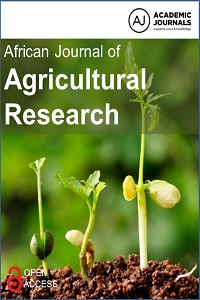Assessing yield stability and adaptability of Andean common bean genotypes in the semi-arid environment of Botswana
Common bean (Phaseolus vulgaris L.) is a vital source of nutrients worldwide. It is one of the most consumed grain legume in Botswana. Fourteen Andean common bean genotypes were evaluated in four environments (two seasons and two diverse agro-ecologies) to determine the effect of genotype and environment interaction and yield stability. The genotypes were grown in a randomized complete block design with three replications. Grain yield data was analyzed on additive main effects and multiplicative interaction (AMMI), cultivar superiority index, Wricke’s ecovalence and Finlay and Wilkinson regression. There was a lack of variation among the selected genotypes, while environment and genotype × environment interaction (GEI) was significant (P <0.01), which is an opportunity to select stable genotypes across environments. AMMI model for total variation revealed that the environment effect was dominant at 36.83%, genotype × environment interaction at 19.82%, while genotype alone was 3.38%. The cumulative sum of squares of the first two interaction principal component axes (IPCAs) accounted for 76.13% of interaction. Stability coefficients consistently identified genotypes DAB494, CAL96 and DAB541 as the most stable and well adapted, besides the low yield realized. These genotypes are useful for stability breeding purposes and for introduction to the semi-arid environment of Botswana.

